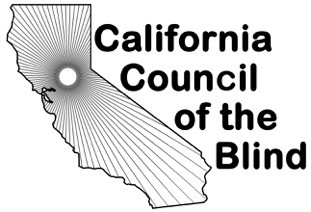by Alice McGrath
[Editor's Note: Alice McGrath is no stranger to the BC. We have seen her convention reports (as a member of the Silicon Valley Chapter) and her article
"The Best And Brightest Stars at The National Braille Challenge" appeared in the Fall, 2013 BC, as well as a brief article on the CCB Women's Group, BC
Summer 2014.]
We were poised for entering our first Class Two rapid on the American River in our bright red, inflatable kayak, and my heart was pounding as I listened
to the commands, from Dian, my sighted kayaking partner. Since I am almost totally blind, all I could do is hear the sound of the rapids as they cascaded
over the rocks and feel the water splashing my face. I focused all my attention on what Diane was telling me to do: paddle left, paddle right, paddle
hard! When we managed to get through the rapid without mishaps, my first thought was, "Yikes, how many more rapids do I have to go through before this
day is done?"
Testing limits as a blind or low vision person can happen daily in small and momentous ways. On this amazing day in late October, I was with my significant
other, Rob Turner, who was partnered in an inflatable kayak with his brother Doug. Rob is also totally blind, and he has been sea kayaking with our friend
Diane for a few years. This was also his first experience river kayaking with his novice brother, and we were led by a river guide in her own hard-shell
kayak. The temperature was a warm 82 degrees, and the smells of the river were wonderfully complex; river water, moss, and that crunchy carpet of autumn
leaves.
Our guide taught us the fundamentals and talked the sighted kayakers through the rapids before we entered each rapid. One odd thing about listening to
a rapid and not being able to see it is they all sound huge. The irony is that smaller rapids can sound louder than the bigger ones simply due to the
shallow depth of the water.
Outdoor life is a valued part of my existence. I enjoy camping, hiking and being surrounded by the sounds and smells of nature. I also enjoy testing
my personal limits and fears. Our foursome has camped and white water rafted with a guide in the past and moving to the inflatable kayak was a natural
next step. On our first white water rafting trip a few years back, I was thrown into the river and then promptly plucked up by the guide back into the
raft sputtering and shivering. I knew I did not want to repeat that experience, and in retrospect, that fear became a block for enjoyment. In the kayak,
after we managed to travel through each rapid without mishap, I first felt relieved, then a little jubilant and finally was vigilantly and tensely awaiting
the next rapid.
After the day was completed, I reflected on the myriad of emotions and thoughts that cascaded through my mind. Even before losing my vision, I would describe
myself as someone who tested personal limits. Losing vision defined these limits in very different ways. Crossing busy intersections during early orientation
and mobility lessons had my heart pounding as much as moving through the rapids of the American River. Once I became more proficient in my travel skills,
other "firsts" pushed me to become the confident person I am today, a woman who happens to be blind.
But what about future white water kayak trips?
For now, I want to pursue sea kayaking rather than the fear and complexity of managing through a river. We are planning a kayak trip to Angel Island, and
even if I end up in the sea, I will not be battling boulders. I know that every day brings opportunities for me to test my limits and expand my comfort
zone. I also know that enjoying the great outdoors is more of a priority, and although I am glad I tested myself, I have nothing to prove, as every day
will bring plenty of new challenges.


